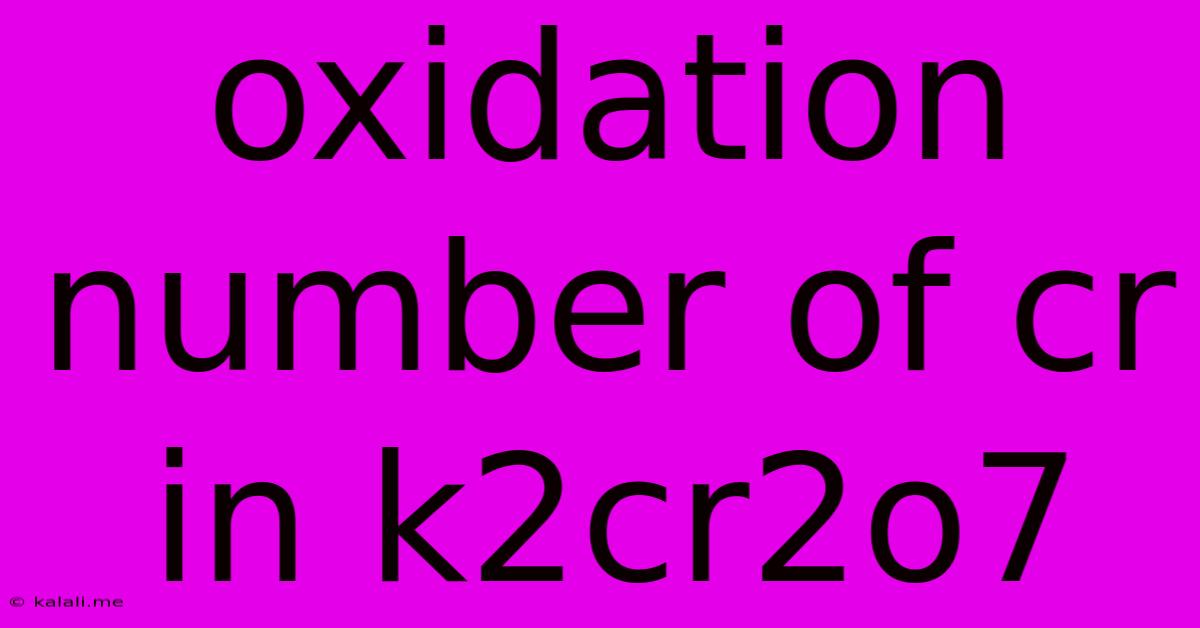Oxidation Number Of Cr In K2cr2o7
Kalali
Jun 15, 2025 · 3 min read

Table of Contents
Determining the Oxidation Number of Cr in K₂Cr₂O₇
This article will guide you through the process of calculating the oxidation number of chromium (Cr) in potassium dichromate (K₂Cr₂O₇). Understanding oxidation numbers is crucial in chemistry, especially when balancing redox reactions and predicting chemical behavior. This seemingly simple calculation involves applying a few fundamental rules. Let's dive in!
What is an Oxidation Number?
Before we begin, let's briefly define oxidation numbers. The oxidation number, also known as oxidation state, represents the hypothetical charge an atom would have if all bonds to atoms of different elements were completely ionic. It's a useful tool for keeping track of electron transfer in chemical reactions. It's important to remember that oxidation numbers are assigned, not measured experimentally.
Rules for Assigning Oxidation Numbers
To successfully determine the oxidation number of chromium in K₂Cr₂O₇, we need to follow a few established rules:
- The oxidation number of an element in its free state is zero. For example, the oxidation number of elemental oxygen (O₂) is zero.
- The oxidation number of a monatomic ion is equal to its charge. For example, the oxidation number of Na⁺ is +1, and the oxidation number of Cl⁻ is -1.
- The sum of the oxidation numbers of all atoms in a neutral molecule is zero.
- The sum of the oxidation numbers of all atoms in a polyatomic ion is equal to the charge of the ion.
- Group 1 elements (alkali metals) have an oxidation number of +1.
- Group 2 elements (alkaline earth metals) have an oxidation number of +2.
- Oxygen usually has an oxidation number of -2, except in peroxides (like H₂O₂) where it is -1 and in superoxides where it has a fractional oxidation number.
- Hydrogen usually has an oxidation number of +1, except in metal hydrides (like NaH) where it is -1.
Calculating the Oxidation Number of Cr in K₂Cr₂O₇
Now, let's apply these rules to determine the oxidation number of chromium in potassium dichromate (K₂Cr₂O₇):
-
Potassium (K): Potassium is an alkali metal (Group 1), so its oxidation number is +1. Since there are two potassium atoms, the total contribution from potassium is 2*(+1) = +2.
-
Oxygen (O): Oxygen usually has an oxidation number of -2. There are seven oxygen atoms, giving a total contribution of 7*(-2) = -14.
-
Chromium (Cr): Let's represent the oxidation number of chromium as 'x'. Since there are two chromium atoms, the total contribution from chromium is 2x.
-
Applying Rule 3: The sum of the oxidation numbers in a neutral molecule is zero. Therefore, we can set up the equation:
(+2) + 2x + (-14) = 0
-
Solving for x:
2x = 12 x = +6
Therefore, the oxidation number of chromium (Cr) in K₂Cr₂O₇ is +6.
Conclusion
By systematically applying the rules for assigning oxidation numbers, we have successfully determined that the oxidation number of chromium in potassium dichromate is +6. This knowledge is fundamental to understanding the chemical reactivity and redox properties of this important compound. Remember to practice applying these rules to various compounds to solidify your understanding. This will enhance your ability to tackle more complex chemical calculations in the future.
Latest Posts
Latest Posts
-
The Outermost Layer Of The Sun Is Called
Jun 16, 2025
-
Which Of The Following Is Not An Equation
Jun 16, 2025
-
The Opportunity Cost Of Holding Money
Jun 16, 2025
-
Which Of The Following Statements Is True Regarding A Vpn
Jun 16, 2025
-
The Rorschach Inkblot Test Is An Example Of
Jun 16, 2025
Related Post
Thank you for visiting our website which covers about Oxidation Number Of Cr In K2cr2o7 . We hope the information provided has been useful to you. Feel free to contact us if you have any questions or need further assistance. See you next time and don't miss to bookmark.